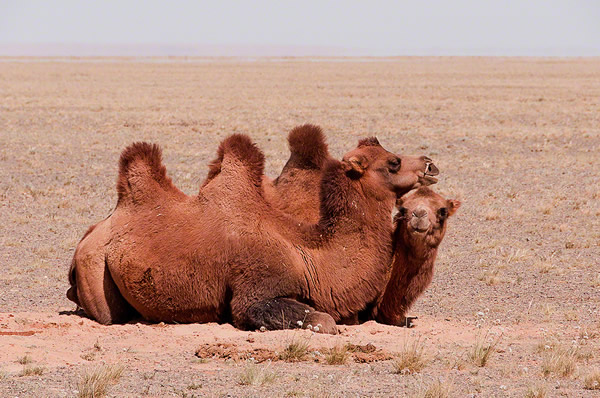 |
| Bactrian Camel |
The bactrian camel and the better–known Arabian camel (Camelus dromedarius) are the only two living species of true camel. Whereas the Arabian camel has only one hump, the bactrian camel has two.
An average bactrian camel stands 6 to 7.5 feet (1.8 to 2.3 meters) in height and weighs between 1,000 and 1,575 pounds (455 and 715 kilograms). The coat of a wild bactrian camel is short and gray-brown in color; that of a domestic or tame version of the animal is long and dark brown.
The bactrian camel is well adapted to its desert habitat. Its special eyelids help wipe sand from the surface of the animal’s eye. Its nostrils close to slits to keep out blowing sand. Its broad, thick-soled feet allow it to move steadily and quickly over shifting sand, achieving speeds up to 40 miles per hour (64 kilometers per hour).
  |
The humps of the bactrian camel store fat like those of other camels. When full, the humps are plump and erect. If the animal has not eaten for a period of time, the humps begin to shrink and sag to one side.
Bactrian camels eat mostly low-lying desert shrubs; they also may eat grasses and the leaves of trees growing near water. The camels may go without drinking water for long periods of time only if they receive enough moisture from the plants they eat.
Male bactrian camels fight for the opportunity to mate with female bactrian camels. The competitions between males are quite fierce and some end in death. A dominant male will gather a group of 10 to 20 females with which to mate.
After a gestation (pregnancy) period of almost 13 months, a female bactrian camel gives birth to a single infant, usually in March or April. The infant camel, weighing about 80 pounds (36 kilograms) at birth, nurses for at least its first year.
Habitat and current distribution
Wild bactrian camels inhabit desert and steppe (semiarid, grass-covered plain) areas in lowland and mountain regions. In Mongolia, they are found in and around the Great Gobi National Park, a protected area of the Gobi Desert located in southwestern Mongolia.
Biologists (people who study living organisms) estimate that 350 camels live in this area. In China, an estimated 600 wild bactrian camels are found in the western provinces of Xinjiang (Sinkiang) and Gansu (Kansu).
History and conservation measures
Humans in China and Mongolia probably began to use bactrian camels as pack animals to carry supplies as far back as 2500 B.C. Up until the beginning of the twentieth century, the range of wild bactrian camels extended from Asia Minor to northern China. As human populations grew in this large area, the camels were confined to a smaller and smaller range.
Habitat loss continues to be a major threat to the bactrian camel. Both Chinese and Mongolian governments have declared the camel a protected species.
Several reserves have been established to safeguard the animals: the Great Gobi National Park in Mongolia, the Annaba Nature Reserve in Gansu, and the Altun Mountain Nature Reserve in Xinjiang. However, wolves continually prey on bactrian camels in the Gobi Park, and those camels that stray outside of the park are often killed for food by humans.
In 2000, China established a new park, the Arjin Shan Lop Nur Nature Reserve. The population is still in decline, and interbreeding with domestic camels has further reduced the population of genetically pure wild bactrian camels.
In 2002, the International Union for Conservation of Nature and Natural Resources (IUCN) raised the status of the wild bactrian camel from endangered to critically endangered.
A series of five expeditions into China and Mongolia in the late 1990s produced data showing that the species faces a population size reduction of at least 80 percent within the next three generations due to continued hunting, increased killings by wolves, and breeding with domestic camels throughout the area.
In China, illegal mining, gas-pipe installation, and proposed industrial development are rapidly destroying camel habitat. Because of the extreme threat to the survival of the species, conservation programs have become urgent.
In 2002, there were only 15 wild bactrian camels in captivity in China and Mongolia. The species breeds slowly, so it is essential to begin breeding-in-captivity programs without delay in order to save the species from possible extinction in the next few decades.
